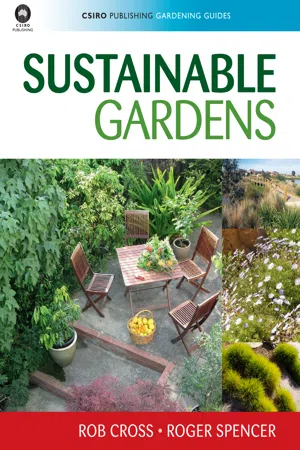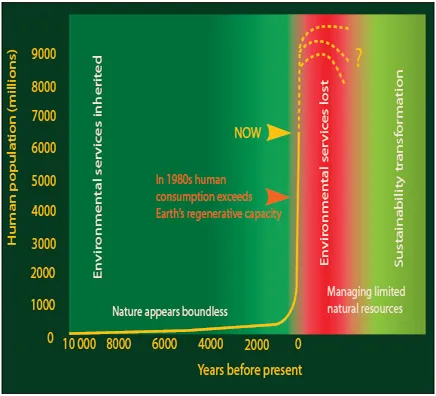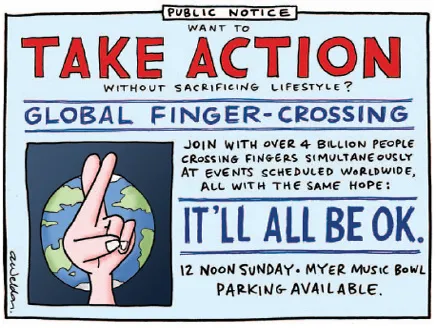![]()
INTRODUCTION TO SUSTAINABILITY
KEY POINTS
Humanity is currently living unsustainably.
Global sustainability action attempts to harmonise economic, social and environmental goals.
Three tools for analysing and managing environmental sustainability:
- management hierarchy
- production and consumption
- sustainability accounting
Human consumption is the driver of environmental impact through the use of the basic resources: water, energy, food and materials.
Sustainable gardening can be defined very simply as: gardening to maximise environmental benefit and human well-being.
This could involve completely different activities such as: encouraging native biodiversity; avoiding the use of synthetic chemicals; growing plants that will not escape into the natural environment; and buying environmentally friendly products. But there is much more to it, as we will see.
Sustainable horticulture is a small part of a global movement whose focus is sustainable living. Although this book will concentrate on the management of urban landscapes, this will make little sense unless we know how this fits into the big sustainability picture. What exactly is sustainability? Why is it important? And how can we become more sustainable?
Living unsustainably
Environmental problems such as climate change, freshwater depletion and species extinction are now global in scale. Nature is no longer keeping up with human consumption of the world’s natural resources (see Figure 1.1). This is sometimes expressed through an economic analogy: instead of living off nature’s interest, we are drawing down its capital by turning resources into waste faster than nature can turn waste back into resources. Addressing this issue will require a major human effort through the 21st century.
Figure 1.1 Living unsustainably.
The Millennium Ecosystem Assessment
The Millennium Ecosystem Assessment (MEA) is the most comprehensive summary of the condition of living systems on our planet and the current biological challenges that we face. It was prepared by over 1360 biological scientists from 95 countries between the years 2001-2005 as an overview of the state of the biosphere. It was scrutinised by governments and published in March 2005.
The MEA was compiled explicitly as a scientifically reliable account of the biological state of the planet, to be used as a guide for decision-makers and those developing environmental policy. Two of the main findings from this report express the stark situation that confronts us:
- Over the past 50 years, humans have altered ecosystems more rapidly and extensively than in any comparable period of time in human history in response to rapidly growing demands for food, fresh water, timber, fibre and fuel. This has resulted in a substantial and largely irreversible loss in the diversity of life on Earth.
- The changes that have been made to ecosystems have contributed to substantial net gains in human well-being and economic development, but these have been achieved at growing costs in the form of the degradation of many ecosystem services [benefits derived from nature, such as a regular supply of rainwater, clean air and nutrient cycling], increased risks of nonlinear changes [suddenly triggered large changes, such as shifts in the circulation pattern of ocean currents], and the exacerbation of poverty for some groups of people. Unless addressed, these problems will substantially diminish the benefits that future generations obtain from ecosystems.
The MEA assessed the condition of 24 ecosystem services and found that only four have shown improvement over the last 50 years, 15 are in serious decline, and five are in a precarious condition. The Report draws attention to the escalating effects of a global population that is growing in number and increasing in affluence.
Figure 1.2 Human use of the Earth.
Figure 1.2 is a simplified summary of human resource use, including our use of nature. When the human population was relatively small, the Earth would have seemed boundless, and nature productive beyond human need and therefore in limitless supply. The use of the concentrated energy in fossil fuels combined with advanced technology and modern medicine during the Industrial Revolution sparked a human population explosion until, in the 1980s, human harvesting of the Earth exceeded the Earth’s capacity to regenerate. This trend is still gathering momentum.
The task for sustainability is to break the link between, on the one hand, human population increase and economic growth and, on the other, environmental degradation and resource depletion. This is an enormous undertaking.
What is sustainability?
In 1972, the Club of Rome (a scientific think-tank) published Limits to Growth – a compelling scientific case for the common-sense argument that, on a planet with limited resources, there are limits to growth. The book sold more than 30 million copies worldwide. Now, over 35 years later, we have yet to develop strategies that will secure our future. We are currently approaching a broad range of environmental limits. Natural systems have diminished to the point where we now have little additional arable land for crops. In many parts of the world, readily available freshwater is becoming scarce and this in turn creates difficulties for irrigated food production and therefore food security. As a global community we cannot simply move on to somewhere more bountiful as our ancestors did.
We are the custodians of planet Earth and this requires a protective attitude to nature and the resources that remain.
The starting point for sustainability as a special goal for humanity is generally accepted as the publication in 1987 of the United Nations Brundtland Commission Report on Sustainable Development. It states:
Sustainable development is development that meets the needs of the present without compromising the ability of future generations to meet their own needs.
Since the Report’s publication, sustainability has come to mean many things, but a broadly held definition involves the promotion of a dynamic balance between three key factors:
- protection of the natural environment
- maintenance of economic security
- respect for social values.
More specifically, sustainability implies that none of these factors can be pursued in isolation; to function properly as a society we must treat them as interdependent and this may require the reconciliation of competing interests.
The challenge to live sustainably involves consideration of two important ‘stakeholders’, neither of whom have a political voice: the non-human organisms on the planet, and future human generations.
As an idea, sustainability has now been accepted by corporations, government and the general public. More and more people now perceive the Earth as a ‘global village’, an international community with a shared fate and the need for a cooperative international approach to resolve problems such as hunger, poverty and global environmental issues. But there is hard work ahead. Here in Australia, we are still on average travelling further, living in larger houses with fewer occupants, using more energy, consuming more resources and producing more waste.
The environmental component of sustainability, which is the focus of this book, requires us to live in greater balance with the rest of the living world, leaving enough resources after human harvesting, to maintain healthy and diverse living systems. Ensuring environmental sustainability is one of the eight Millennium Development Goals for 2015 set out in the United Nations Millennium Declaration in September 2000 and endorsed by 189 countries.
Sustainability management
Saving life on Earth is not a spectator sport.
ANON.
Figure 1.3 ‘Fingers crossed’. (© Andrew Weldon)
The future is not fixed; it is in many ways something we create ourselves.
ANON.
We know that things are not right on Planet Earth but at present we are not sure how best to help. What can we do to lead more sustainable lives? This is not always obvious, as the following newspaper extract shows.
Sometimes you just feel like Kermit the frog. With so many green messages pulling us this way and that, it’s hard to know how green your green choices really are. Should I go solar or wind? What about GM-free, chemical-free or free-range? Are they better than CFC-free, triple-A rated or energy-efficient? Even in your quietest, energy-saving moments you can wear yourself out just thinking about minimising your ecological footprint on the planet. Is it enough that I only flush for Number 2s and always turn the tap off during teeth brushing or should I overhaul the plumbing and reticulate the grey water via planet-killing plastic tubing all through my garden? … I’ve come to think of my backyard as a mini carbon-sink – the eucalypts, wattles and coastal tea-trees breathing as fast as they can to compensate for the car fumes … And I always take a canvas bag to the supermarket, which offsets the fact that I’ve taken the car to carry the shopping home without overbalancing on my bike … Does the Australian flag on the label mean Australian-made or Australian-packaged and does it really matter? Are these tomatoes gleaming with natural health or is it really cochineal? …
TRACEE HUTCHISON1
All things are connected
This excerpt illustrates how hard it is to make decisions about how to live more sustainably. Ways of tackling sustainability seem infinite, from international legislation to changes in individual lifestyle, from political action to innovative technology, and much more.
Tracee’s questions are hard to answer partly because there is at present a lack of information. But they are also difficult to answer because of the complexity of the web of connections that we deal with unwittingly every day. Direct environmental impacts like land clearing, logging and water pollution are easy to understand, but the connection between our consumption patterns and environmental deterioration is much less clear, and the constant barrage of alarming statistics can produce a feeling of helplessness that stifles any enthusiasm for positive change.2
How do I decide what is best? Am I ‘sweating the small stuff’?
Answering this question will take up the rest of this book. But in coming to grips with sustainability there are three important management tools that we must introduce, because they underpin everything that follows. These three tools are:
- the sustainability management hierarchy
- the cycle of production and consumption
- sustainability accounting.
Sustainability management tools
The sustainability management hierarchy
As the world becomes more environmentally, socially and economically integrated, so the future becomes more a global responsibility.
ANON.
The world’s greatest advances often begin with one person or small groups of people following an idea.
ANON.
Living systems consist of a number of organisational levels (scales, contexts or frames of reference). For example, animals and p...



